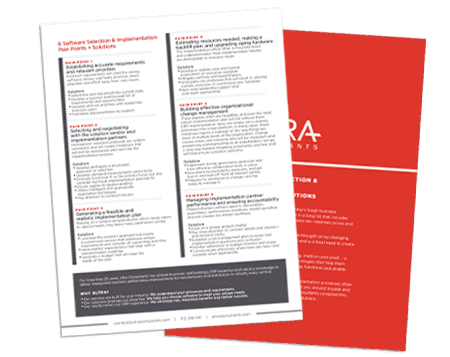CRM has changed a lot since its heyday in the early 2000s. Back then, it was all about upselling customers on products. But today, CRM has evolved into more of a customer experience management solution that encompasses sales and marketing while tying back into ERP systems. For companies that are looking at different CRM solutions, either as a completely new addition to their technology stacks or something to replace a legacy system, there’s plenty to think about. Here’s how to select the right CRM for today’s challenges.

What to Consider When Selecting a New CRM Solution
The first piece to look at when choosing a new CRM system is whether or not it integrates with the existing ERP system. If the CRM system is from the ERP vendor, this isn’t an issue. However, third-party CRM systems may require connectors, although most of the larger vendors have pre-built integrations. In this vein, it’s also worth it to explore whether or not using a third-party system would incur additional fees to access the ERP system’s data.
Next, companies will want to look at the functional group they’re delivering the CRM system to. Sales, marketing, and customer service teams will all have different needs, and most CRM systems do a good job with pipeline and opportunity management, since CRM has deep roots in sales. Companies just looking for a tool for sales have their pick of almost any CRM system available.
But for companies looking at CRM for marketing, that requires a completely new set of functions, like the ability to personalize communications and target specific customer segments. This narrows the field a bit in terms of what can be chosen. Marketing is more data-driven and needs integration into third-party sources, including social media. Additionally, in the retail industry, they need to connect with retail websites to provide that personalized experience.
Using CRM for customer service can create even more requirements. Agents typically handle case management, returns management, and claims, and they need a level of integration with order management. Being able to access customer contact information becomes even more critical, and integration with ERP systems is a must.
Typically, companies won’t try to implement CRM in all three departments at once. For those new to CRM systems, starting with sales and then moving into marketing, then customer service, may be the path of least resistance. Some start with customer service, then move into sales and marketing. It all depends on how they’re using CRM systems to achieve their business goals.
Choosing the CRM selection team
It may be tempting to populate the entire selection team with the sales department. But unless the entire goal of the CRM implementation is to support sales, the team won’t have enough knowledge to choose a system that works for the rest of the organization.
Ideally, the CRM selection team will have stakeholders from every department that will be affected by its use and be led by someone from the sales team that is well-versed in the organization’s processes. Additionally, the finance team will need to be engaged because of how the CRM system will impact customers and what kind of controls will be placed on business rules.
For those that can, including a business analyst on the team can provide a tremendous amount of insight into how the CRM system will work with existing processes. Organizations need to choose one aligned to the project, but have the analyst serve as an advisor, rather than a project lead.
How CRM applications are licensed
Finally, it’s important to look at how different CRM applications are licensed before making a final decision. While most of today’s offerings are cloud-based, it is possible to purchase a one-time license with a yearly maintenance agreement and install some systems on-premise. This is a higher up-front cost but can be beneficial for organizations that have the resources to maintain an in-house deployment. However, more companies are eschewing this model because of the cost and the lack of flexibility.
The SaaS model that’s become so popular is most commonly licensed on a per-user, per-month cost. However, some vendors also offer a consumption-based model, where theoretically organizations pay only for what they use.
What it will boil down to for many organizations is their own goals for the CRM system and how offerings from different vendors align with those goals. While the landscape for CRM solutions is narrower than the ERP landscape, there are still choices that can meet most companies’ needs.
During an ERP selection project, look for an ERP vendor that offers tight integration between ERP & CRM.
6 SOFTWARE SELECTION & IMPLEMENTATION PAIN POINTS + SOLUTIONS
Software selection and implementation processes often present challenges of their own. To steer you around trouble and help you drive success, Ultra’s experts compiled a list of pain points and solutions to be aware of as you embark on this journey.







